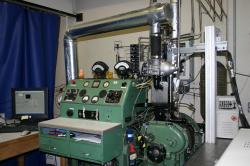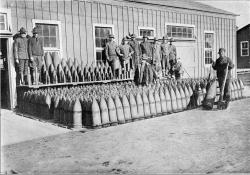The Cooperative Fuel Research (CFR) engine is used extensively throughout the world for testing, research, and instruction in the performance of fuels and lubricants for the internal combustion engine. Principal design work on this prototype engine was accomplished by engineers of Waukesha Motor Company, now a division of Dresser Industries, who served on a Cooperative Fuel Research Committee with representatives of the American Petroleum Institute, Society of Automotive Engineers, Automobile Manufacturers Association, and the National Bureau of Standards.
Research and Development

YearAdded:
Image Credit: Courtesy Colorado State UniversityImage Caption: Cooperative Fuel Research EngineEra_date_from: 1928
1980

The idea of constructing a rotating boom for
hydromechanical tests at the Alden Hydraulic Laboratory
originated with Professor Charles Metcalf Allen, head of
the lab from 1896 to 1950. The original boom was designed
in 1908 by Professor Allen, assisted by two Worcester
Polytechnic Institute students.
Professor Allen needed a moving test stand for hydraulic
experiments and for rating current meters.
YearAdded:
Image Credit: Courtesy ASMEImage Caption: L.J. Hooper (left), Charles M. Allen (center) and Clyde W. Hubbard (right) sit together on the rotating boom.Era_date_from: 1908
1982

During the 1930's, research into advanced ballistic measurement techniques began at Aberdeen Proving Ground—the world's first large-scale, fully-instrumented ballistic range producing data on the aerodynamic characteristics of missiles in free flight.
YearAdded:
Image Credit: Courtesy U.S. Army RDECOMImage Caption: High Explosive shells at Aberdeen Proving GroundEra_date_from: 1943
1982

This inertia dynamometer is used to test railroad wheels under controlled conditions that can greatly exceed normal service. It is the first and only railroad dynamometer to test track wheels using vertical and lateral loads, as well as thermal braking loads, at the wheel rim. It can also test railway car and locomotive axles.
YearAdded:
Image Caption: AAR Railroad-wheel DynamometerEra_date_from: 1955
1988


